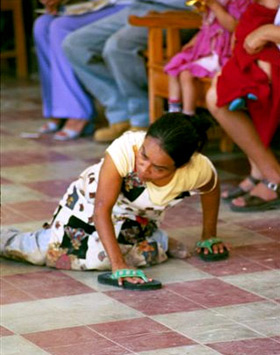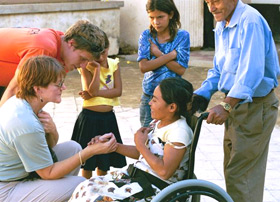|
|
In South America, a woman with cerebral palsy has been lying in bed for seven years in a back bedroom of a cinder-block home. In Africa, a young girl with Down syndrome is left on a river bank to perish because her parents believe she is a bad omen. In Western nations, disabled infants are sometimes starved to death before they are a week old. In Asia, a slum dweller with polio is told he must journey through eight reincarnations before he can be considered a “whole person.”
These are the people God cares passionately about. When you read the four Gospels, it is evident that Jesus has great compassion for people with disabilities and their families. Often, the Gospels show Jesus preferring to spend time with the “least” rather than with people of wealth, influence, power, or even those in the religious hierarchy. Whether it was the man born blind in John 9, or the individual with the withered hand in Luke 14, Jesus was “moved with compassion” whenever he encountered people with disabilities.
I sense this compassion every time I wake up in the morning. I have lived in a wheelchair as a quadriplegic for forty years—I broke my neck in a diving accident when I was very young. At first, I was bitter and angry toward God. But loving Christians reached out to my family and me, showing us the compassion of Jesus Christ. It was the love of Jesus which melted away my bitterness and gave me a new confidence in God's purpose and plan in my life through this wheelchair. Today, many years later, I work with the Joni and Friends International Disability Center to fan the flames of Christ’s love to other disabled people around the world who need the help and hope of our Savior.
Who Are People with Disabilities?
Who are the world’s disabled? In 1996, the World Health Organization estimated that between ten and eleven percent of the world’s population has a disability. This works out to be up to 600 million people.1 There is a need, especially in less developed countries, for over twenty million wheelchairs.2 The world of disabled people is varied—in countries with rich resources, some people with disabilities may enjoy educational opportunities, be gainfully employed and live independently. But globally, this is the exception, not the rule.
![]() Disabled people in most parts of the world struggle to survive. Sadly, their needs are often overlooked or even ignored by the local church. Disabled people in most parts of the world live in crushing poverty and isolation. They lack simple mobility and are often hidden away in back bedrooms because of fear and prejudice. In many countries, the only income a disabled person has is by begging. In cultures gripped by social stigmas, parents may maim a child, hoping that as a beggar he or she will evoke sympathy from passers-by. In some countries, people who are learning disabled (e.g., mentally retarded, Down syndrome or cerebral palsied) are unnecessarily institutionalized or warehoused in mental wards. This sad situation also occurs among many deaf and deaf-blind people.
Disabled people in most parts of the world struggle to survive. Sadly, their needs are often overlooked or even ignored by the local church. Disabled people in most parts of the world live in crushing poverty and isolation. They lack simple mobility and are often hidden away in back bedrooms because of fear and prejudice. In many countries, the only income a disabled person has is by begging. In cultures gripped by social stigmas, parents may maim a child, hoping that as a beggar he or she will evoke sympathy from passers-by. In some countries, people who are learning disabled (e.g., mentally retarded, Down syndrome or cerebral palsied) are unnecessarily institutionalized or warehoused in mental wards. This sad situation also occurs among many deaf and deaf-blind people.
Disabled people in industrialized countries face different challenges. In most Western nations, abortion, infanticide and euthanasia are seen as disability-prevention strategies (one is “better off dead than disabled”). When a society is influenced by secular humanism, disabled people who lack the resources to live independently are viewed as a drain on economic resources.
Whether in wealthy or developing countries, disabled people are frequently cut off or marginalized from society. Because they are not mainstreamed into the community, they do not enjoy ready access to the local church. Often, the church building is inaccessible (stairs, no ramps, narrow doorways, etc.). Church programs quite often can be equally inaccessible or non-existent.
|
|
If we were to place these 600–650 million people together, they would comprise the world’s third largest nation with the highest rates of homelessness, joblessness, divorce, abuse and suicide. People with disabilities are often the victims of crime and abuse. A polio survivor from Ethiopia has said, “Women in wheelchairs, like me, are easy targets of rape and physical abuse. People know we can’t defend ourselves.”3
Where Is the Church?
Only five to ten percent of the world’s disabled are effectively reached with the gospel, making the disability community one of the largest unreached (some say under-reached) or hidden people groups in the world. Jesus, aware that this population would be overlooked, made people with disabilities a target group of the Great Commission (Luke 14:12-24). He said, “Go out… find the lame, the blind and the disabled… and bring them in.” Then he added, “Do this and you will be blessed.” ![]()
The Church has the opportunity to lead the way in transforming the plight most disabled people face by serving and becoming a loving, healing community to this population. Christians in cities and villages around the world can truly demonstrate the same compassion of Jesus Christ that he showed toward disabled people throughout the Gospels. How can the Church change its attitude toward people with disabilities? The answer is simple: it begins with you.
Personal Models
Your attitude should be the same as that of Christ Jesus (Philippians 2:3-5). So let us consider how Jesus would relate to someone with a disability. The following are personal guidelines for you to follow when encountering a disabled person or his or her family:
- Review in the Gospels the example of Jesus and how he treated disabled persons. Ask several Christians to pray for you as you endeavor to reach out to the disabled in your community.
- Do not look at the person’s impairment; look into the eyes and smile.
- Reach out and touch the person, if not with a handshake, then with a hand on the shoulder. Do not pat a person’s head as you would a child.
- Do not shout at a blind person; he or she can hear you.
- Use a pencil and paper to communicate with a deaf person. If he or she cannot read, you can draw pictures.
- Communicate with the disabled person as you would anyone else, asking about family, home or other interests; do not talk only about the disability. Feel free to ask questions; however, avoid questions which are morbid or highly personal.
- Invite the person to church and ask questions as to how you and your congregation might make his or her visit a positive experience. If he or she uses a wheelchair, it may be necessary to construct a ramp using boards. If he or she “walks” using his hands, remember the lesson of James 2:2-4.
- Visit the disabled person in his or her home; this will give you a clear idea of the needs of the family. Find a way to help the family. Remember that they also are weary and isolated. In Proverbs 31:8-9, God calls us to advocate on behalf of the disabled.
- Introduce the disabled person to other members of your congregation.
![]()
Church Models
There are many ways for a church to show the compassion of Jesus Christ to disabled people in their village or city. The following are a few models I would suggest:
- Build-a-Ramp Day. Make your church ready to welcome wheelchair users by asking skilled workers in your congregation to build a ramp or widen doorways. They may wonder why they are doing this, since no one with a wheelchair comes to church. Explain in a short Bible study how God wants us to prepare a place for his people. Use the passage in Luke 14.
- Mothers’ Day Out. Mothers of disabled children rarely get a break. Design a two-hour Saturday morning program held once a month for mothers of special needs kids. Provide a sitting service for the disabled child while mom enjoys fellowship with other women at the church doing sewing activities, getting her hair styled, filing fingernails, receiving a pedicure, swapping recipes, etc. Make sure to provide volunteers who will organize refreshments and guide the activities. A day of “pampering” like this underscores the care and compassion of God as demonstrated through loving Christians. Make sure to give the gospel message at the close of the morning session.
- Foot Washing Service. In many developing nations, disabled people do not have mobility equipment, but must “crawl” on their hands and knees. These people “walk” using flip-flops or slippers on their hands, while supporting their weight with their knees. Your church can design a community outreach to these disabled people by holding a foot washing service (involving feet, legs and knees). During the service, give a message from John 13:5-14. Remember to (1) use volunteers who have a background in nursing or working with disabled people and (2) administer basic first aid to any parts of a disabled person’s limbs which have become sore or bruised. Complete the foot washing with lotion. Give small gifts to the disabled people and make certain to welcome them back for other church services.
Do you recall the stories I mentioned in the beginning of this article? I earnestly pray that the Church in South America will regularly visit women with cerebral palsy in those back bedrooms. God can call you to do the same in your ministry! In Africa, God has called a pastor to rescue disabled children from the river banks and give them hope, help and a home. God can call you to do the same in your ministry! In Western nations, God has called a Sunday school teacher to tell mothers that their disabled unborn child is by God’s design. God can call you to do the same in your ministry! In Asia, God has called an elder to give the gospel truth to the slum dweller with polio who feels he must be reincarnated. God can call you to do the same in your ministry!
“Go out, find the poor, the crippled, the blind and the lame and bring them in.” It is what Jesus Christ would want you to do.
For more information on how you and your church can share the love of Jesus Christ with disabled people in your community, contact Dr. Chip Kingery, international director of Joni and Friends International Disability Center, at ckingery@joniandfriends.org or you can write us at P.O. Box 3333, Agoura Hills, California, USA 91376.
Endnotes
1. World Health Organization. Declining Resources for Rehabilitation: A Matter of Concern. 30 January 1996.
2. Hof, Henry, Ralf Hotchkiss and Peter Praelzer. 1993. “Building Wheelchairs, Creating Opportunities.” Technology and Disability, International Perspectives. 2(2).
3. Personal conversation with Diana Mood, director of Global Transformation Network.



